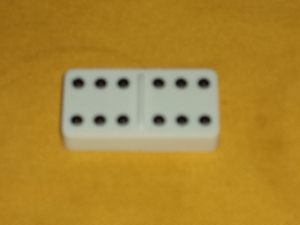Due to the nature of my disability, I’ve often been deprived from enjoying most of the games that I used to play when I was sited. In that back drop, I’ve usually been looking for newer or adaptive games that both sited and blind can play on equal grounds.
About 5 years ago, in 2008 on my last visit to UK I got a chance to learn a new game call “Domino”. Apparently the Domino is not a popular game in Sri Lanka, so I hadn’t heard of that game until it was introduced to me by an Englishmen during my stay at St-Danstan’s (UK).
It is a very simple but yet interesting game which you can play with 2 or more players.
The four most common domino sets are the double-6, double-9, double-12, and double-15 sets. The larger sets (double-9, -12, and -15 sets), allowing for a larger number of players. The set is named after the domino in the set with the highest number of pips. Most domino games are designed to be played with the double-6 set and it contains 28 tiles.
Dominoes are small, flat, rectangular-shaped game pieces usually made out of plastic.
Domino pieces are usually twice as long as they are wide and it may be of any size, but an ordinary domino is about one inch wide and two inches long. Like a playing card, a domino has a face and a back. The back of each tile is either blank or decorated with a design. The face of each tile is divided by a line across the center separating the piece into two square halves. Numbers are represented in each half by spots, commonly called pips, or the absence which represents zero. An individual domino is named for the number of pips it has on each half of its face. For example, a domino face with 3 pips on one half and 5 pips on the other half is called the 3-5 dominoes. Dominoes with the same number of pips on each half of the face are known as doubles.
There is a special domino set for the blind and those dominoes are made with protruded pips and lines to enable blind players to identify the pieces. Upon my request, one of Sri Lankan charity organization based in UK “Ranaviru fund” donated couple of adaptive domino sets along with several other devises to Ranaviru Sevana- Ragama. Those items were purchased from Royal national institute for blind (RNIB) – UK.
The game is finished once a certain number of hands have been played or a player or team makes the necessary points to win. A player’s position at the table in a game with three or more players is called a seat.
One way to determine seating arrangements is by lot. After the tiles are shuffled, each player draws a domino from the stock. The player who draws the
Tile with the greatest number of pips has first choice of seats. The player holding the next highest seats himself to the left, and so on. If there is a tie, it is broken by drawing new dominoes from the stock. The tiles are returned to the stock and reshuffled before the players draw their hands. When a partnership game is played, the partners sit opposite each other.
Before every game, a player shuffles the tiles face down on a flat playing surface, thoroughly mixing them by moving them with his hands. The player’s hands may not stay on the same tiles while shuffling, and the player who does the shuffling should be the last to draw his hand for the game. Usually the winner of the previous game shuffles for the next game.
After the tiles are shuffled, each player draws the number of tiles specified in the rules for the domino game being played and then places them in front of himself in such a way that the other players can’t see the pips on his tiles.
Each player draws his hand from the stock. The player who draws the highest double or heaviest domino of the set (i.e., double-6.If playing with a double-6 set), plays it as the lead. After the first player sets his double, the second play is made by the player to his left and play continues clockwise.
Player making the first play may be referred to as the setter, the downer, or the leader. He should place his tile face up in the middle of the table then the player to his left adds his tile to one of the free ends, and so on, going clockwise around the table with each player adding a tile. Players add tiles that have the matching number of pips with an open end of an already played tile.
As each player matches and plays a tile, a line is formed. This configuration of dominoes is called the layout, string, or line of play. In order to prevent tiles from falling off the table when the line of play extends too far, dominoes may be played in any direction.
The player who is unable to make a play must announce to the other players, “I pass,” and then the next player takes his turn. The games end when a player has played all the dominoes in his hand before the other players and announce, “Domino.”. If no one is able to make a play, the game ends in draw.
Scoring method used in many domino games is to take the losing players’ total number of pips by counting the pips on the tiles left in their hands at the end of a hand or the game and then adding that number to the winner’s score.





